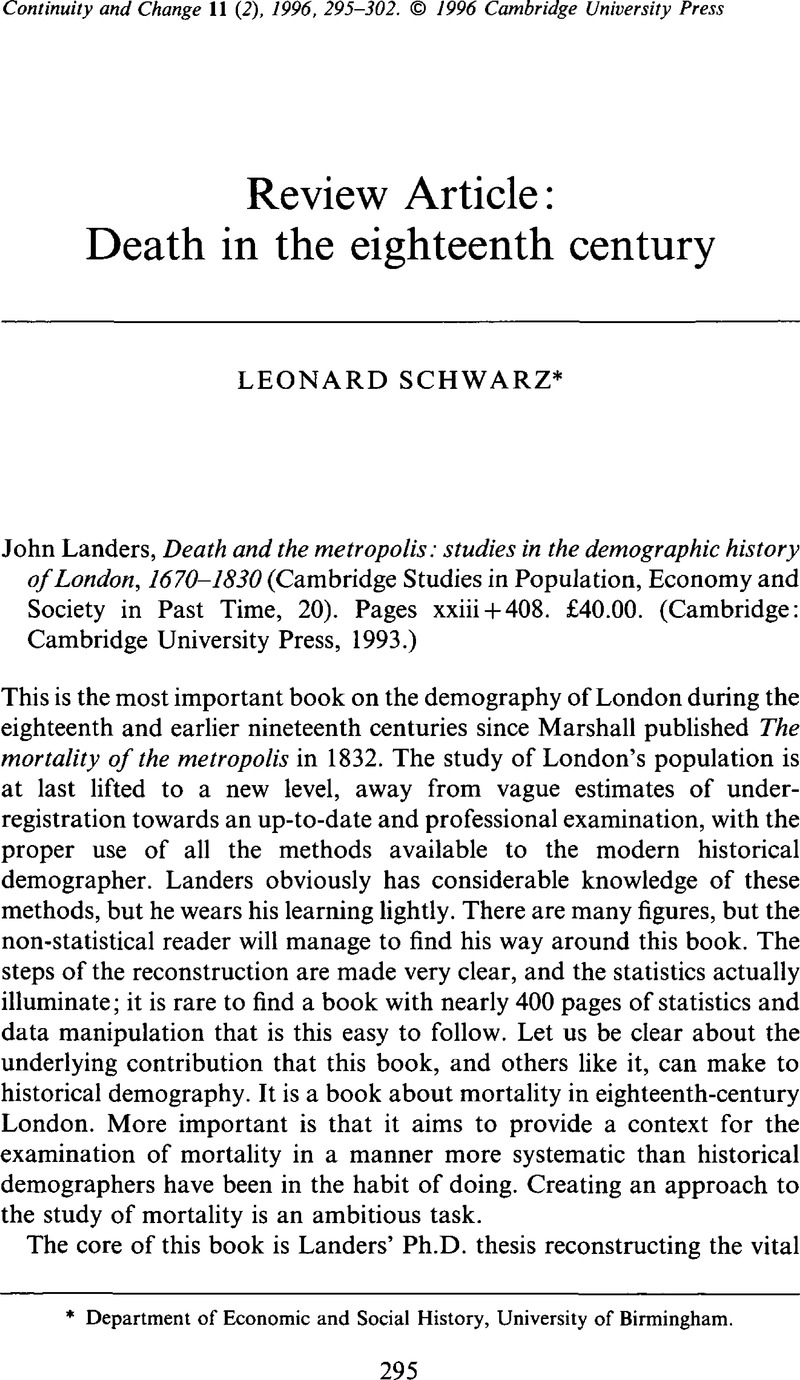No CrossRef data available.
Published online by Cambridge University Press: 11 November 2008

1 The Sharlin thesis – that the death rate among native-born city dwellers was much lower than for immigrants – does not work in Landers' London: see Sharlin, A., ‘Natural decrease in early modern cities: a reconsideration’, Past and Present 79 (1978), 126–38.CrossRefGoogle Scholar
2 Landers' arguments might well have been taken more carefully by Razzell in his recent claim that family reconstitution systematically underestimates the death rate because it omits those who died in neighbouring parishes. By taking Quakers, Landers has avoided this problem; see Razzell, P., ‘The growth of population in eighteenth-century England: a critical reappraisal’, Journal of Economic History 53 (1993), 743–71CrossRefGoogle Scholar. On a national scale, the Quakers also fail to bear out Razzell's suggestion, as he admits (ibid., 765).
3 McNeill, W. H., Plagues and peoples (Oxford, 1977).Google Scholar
4 Variants of the HPM have been discussed by Walter and Schofield (see Walter, J. and Schofield, R., ‘Famine, disease and crisis mortality in early modern society’, in Walter, J. and Schofield, R. eds., Famine, disease and the social order in early modern society (Cambridge, 1989), 1–73, esp. pp. 65–73)CrossRefGoogle Scholar and applied to South-East England during the later seventeenth and earlier eighteenth centuries by Dobson (see Dobson, Mary J., ‘The last hiccup of the old demographic regime: population stagnation and decline in late seventeenth and early eighteenth-century south-east England’, Continuity and Change 4 (1989), 395–428CrossRefGoogle Scholar).
5 Schwarz, L. D., London in the age of industrialisation: Entrepreneurs, labour force and living conditions, 1700–1850 (Cambridge, 1992), 152.CrossRefGoogle Scholar
6 In 1841 e0 in rural England was 43, and in London it was 33, according to Woods' estimates: see Woods, R., ‘The effects of population redistribution on the level of mortality in nineteenth-century England and Wales’, Journal of Economic History 45 (1985), 645–51 at p. 650).CrossRefGoogle ScholarPubMed
7 Wrigley, E. A. and Schofield, R. S., The population history of England, 1541–1871 (1981), 318.Google Scholar
8 Perrenoud, A., ‘The attenuation of mortality crises and the decline of mortality’, in Schofield, R., Reher, D. and Bideau, A. eds., The decline of mortality in Europe (Oxford, 1991), 18–37.Google Scholar
9 Schofield, R. and Reher, D., ‘The decline of mortality in Europe’, in Schofield, Reher and Bideau eds., Decline, 1–17, at p. 16Google Scholar; Galloway, P. R., ‘Long-term fluctuations in climate and population in the preindustrial era’, Population and Development Review 12 (1986), 1–24.CrossRefGoogle Scholar
10 I am not qualified to discuss Preston and van de Walle's dismissal of the importance of smallpox among migrants in their twenties to Paris between 1800 and 1870 on the grounds that migrant mortality in Paris would have had to be approximately three times higher than non-migrant mortality during the first five years after arrival to account for the peak in mortality for the age group 20–24. They ascribed the mortality peak of this age to the prevalence of consumption in the urban catchment area: (see Preston, S. H. and Walle, E. van de, ‘Urban French mortality in the nineteenth century’, Population Studies 32 (1978), 275–97, at pp. 289–90.CrossRefGoogle ScholarPubMed
11 Dobson, , ‘The last hiccup’, 420–1Google Scholar. She does also say that some of the infections would have arrived by sea, but London would have been the largest source of the infections.
12 Schwarz, , London in the age of industrialisation, 125–55.Google Scholar
13 Vann, R. T. and Eversley, D., Friends in life and death: the British and Irish Quakers in the demographic transition (Cambridge, 1992).CrossRefGoogle Scholar
14 So could the different child mortality rates of Vann and Eversley (Friends, p. 203)Google Scholar and Landers, (Death, p. 136).Google Scholar
15 Should they do so, they will be a little misled, as I worked on the basis of a CDR figure of 51.8 per thousand, given by Landers and Mouzas in 1988 as the average figure for 1724–1759, whereas by 1993 Landers had dropped the figure to 48.6 for the 1730s (and 46.0 for the 1740s, p. 175). Given the level of error of these things, the changes are not particularly important, but the figures for mortality per thousand of population in the 1730s in Schwarz, (pp. 134–5) for the 1730s should be reduced to 93.8 per cent of their originals. The CDR dropped from 48.6 to 23 per thousand, and 43 per cent (instead of 42 per cent) of this decline is ‘explained’ by a decline in the incidence of consumption, smallpox and fevers.